Lawn View Farm Jerseys
Lawn View Farm is home to Mennís Jerseys which includes more than 80 registered cows and another 85 registered heifers, bulls for sale, and steers. We have
been shipping our milk on the organic market since January 1, 2009. Since Harvey and Jackie took over the farm in 1989, a heifer barn was constructed (1990)
and the freestall barn to house the milking cows was constructed in 1999. A milking parlor, built in the early 1970's, was remodeled in 1991. In 2009, we had
a Coverall structure put up to house heifers between the ages of 6 month and calving and to store hay.
Menn Lukes Liberty was our first cow to be pictured on the farm
and also our first cow to score Excellent-90.

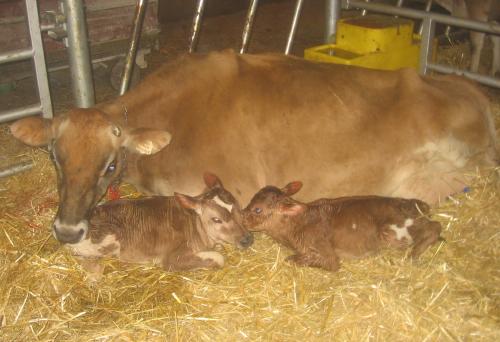
This was our first set of twins in 2006, they are out of "Tammie" a tame,
spotted five year old.
She had a bull and a heifer, "Mickey" and "Minnie".
Mickey is the one to the left, with the white spot on his head.
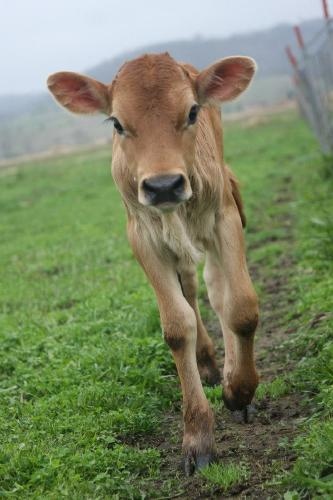 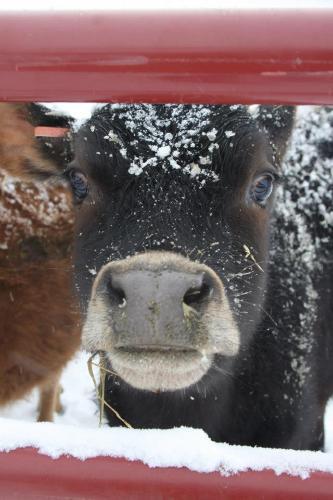 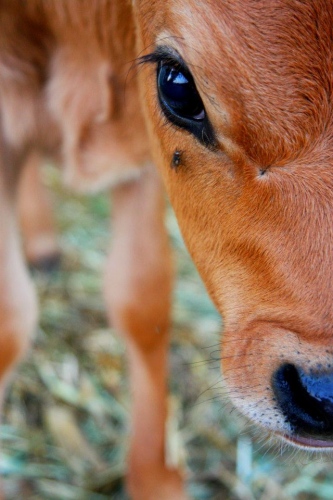
"Walking Calf", "Black Heifer Head Shot" & "Calf with fly on face" Photos by JEM Creation Photography
Raising Jersey Calves
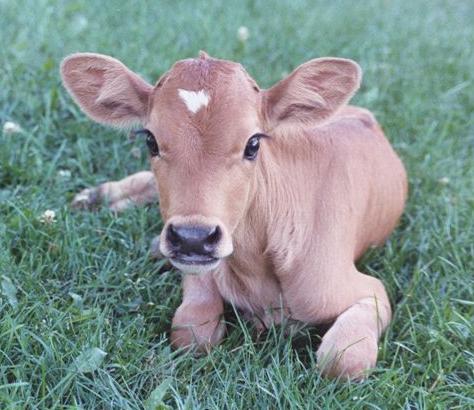
- Birth: Calves born at Lawn View Farm are born in a well bedded calving pen whenever possible. As soon as possible after birth, calves are fed at least 3 quarts of colostrum from a Johne's negative cow, preferably their mother. We freeze colostrum from Johne's negative cows to feed if a cow does not have a suffiecient amount of colostrum for her baby. Colostrum replacers are not approved for organic use. Prior to our organic certification in January of 2009, we were able to use a colostrum replacer. "Acquire" worked the best for us. We can still feed Acquire to bull calves, however, they would lose their organic status.
- Housing: Calves are moved to well bedded calf hutches as soon as possible after birth. Removing them from their mother in a timely manner before they nurse is important to maintain a high level of biosecurity and reduce the calf's exposure to organisms that may cause scouring or Johne's Disease. Calves are fitted with thermal calf coats from September through May to help with warmth and promote faster growth.
- Feeding: Since May of 2006, we have been feeding our calves whole Jersey milk. Prior to our organic certification, we found milk to be more economical and better for the calves than milk replacer. There are no organic milk replacers that we are aware of. We pasteurize the milk in a household pasteurizer from eNasco.com In extremly cold temperatures, the calves receive a third bottle (4 pts) of milk. An 18% protein calf starter and fresh water are offered after two weeks at which time they seem more interested in eating and drinking something other than their bottle.
- Treating scours (diarrhea): Our experience has shown that calves who are going to scour due to failure of passive transfer (from adequate colostrum feeding) will do so between the seventh and tenth day of life. Calves who scours before the seventh day usually die quickly of dehydration despite treatment. For bull calves who do not need to stay organic, treatment for sick calves includes feeding Vitamix (a Frank Lampley product) and Merrick's electrolyte pack up to four times a day to keep calves from dehydrating. Pepto-Bismol or a similar product also helps calves recover. After losing several calves to scours in the winter of 2008-09, we have begun adding 1 ounce (30cc) of aloe vera juice along with a scoop of "Calf Shield" to their milk twice a day as a preventive measure. Humates (Midwest Bio-Ag Charcal) is offered free choice from birth. These help the calf's immune system so she can fight the ailment on her own.
- Health issues: In December, 2005, we experienced yet another new problem in calf raising. Two calves that scoured during sub-zero weather eventually lost both back hooves. Veterinary experts who were consulted concurred that hypothermia was the cause as circulation to the extremities is severely compromised during illness. Heat lamps were installed in hutches of newborns and left on for several weeks to provide additional warmth, but, after we experienced two hutch fires when the lamps fell in the straw this practice has been discontinued!! Since then, we keep the babies in the barn for several weeks after birth or until the temperatures are above 20 at night and in the 30's during the day.
Disclaimer: Information given on this website is provided to help others in their farming pursuits but is not in anyway guaranteed to provide positive results for everyone. Lawn View Farm takes no responsibility for individual results.
Jersey History
Jersey cows originated in Isle of Jersey in the English Channel off the coast of France.
There are no other breeds on the island. Jerseys are one of the oldest breeds of dairy cow.
The Jersey shares a common ancestry with not only the Guernsey breed but also those cattle
found on the Normandy and Brittany coasts. They were first brought to the United States
around 1850, by the early immigrants and became a very popular breed. The Jersey breed
has been purebred since 1763 and the breed standard was formed in 1844. Jersey cows are
found throughout the world because they are adaptable to most climates and are the most heat
tolerant of dairy cows. The Jersey is the second largest number in breeds of dairy cattle in the world. With
an average weight of a Jersey cow of 900 lbs, they are the smallest of dairy breeds. Jersey cows
are the most docile of dairy cow breeds and they are very intelligent. The Jersey bulls have least
docile temperament of the common breeds of dairy cattle and can be surprisingly aggressive and
weigh around 1,500 pounds which is small in cattle standards.
The coloring of Jerseys are usually a shades of fawn or cream, a very light gray, reddish, spotted
white or mouse color to a very dark fawn or a shade that is almost black. The Lighter colors descend
from Norman ancestors and the darker colors are descended from Brittany. Each Jersey produces
about 40 pounds of milk per day, or about 5 gallons. They produce more pounds of milk per pound
of body weight than any other breed, about 13 times their bodyweight in milk each lactation.
Jersey milk is the richest milk, higher in calcium, protein, butterfat, and nonfat milk solids. It is used
in the production of cheese because its butterfat is far superior than other dairy cattle. Jersey
milk is creamy rich and makes the best ice cream and the best lattes ever!
Jersey Links
www.usjersey.com
www.johnes.org
|
|







